SIT773 - Software Requirements: Life Cycle Models Comparative Report
VerifiedAdded on 2022/10/07
|11
|1923
|37
Report
AI Summary
This report provides a comprehensive comparison of various software development life cycle models, including Waterfall, Parallel Development, Iterative, Evolutionary Prototyping, Throw-away Prototyping, and Agile approaches. The report outlines the characteristics, advantages, and disadvantages of each model, along with their associated risks. It also examines how each model accommodates changes in requirements throughout the project lifecycle and their subsequent impact on client satisfaction and project costs. The analysis covers the models' strengths and weaknesses, providing a valuable overview for software development project planning and execution. The report also highlights the importance of selecting the appropriate model based on specific project requirements and constraints, emphasizing the need for careful consideration of factors such as project size, complexity, and client involvement.
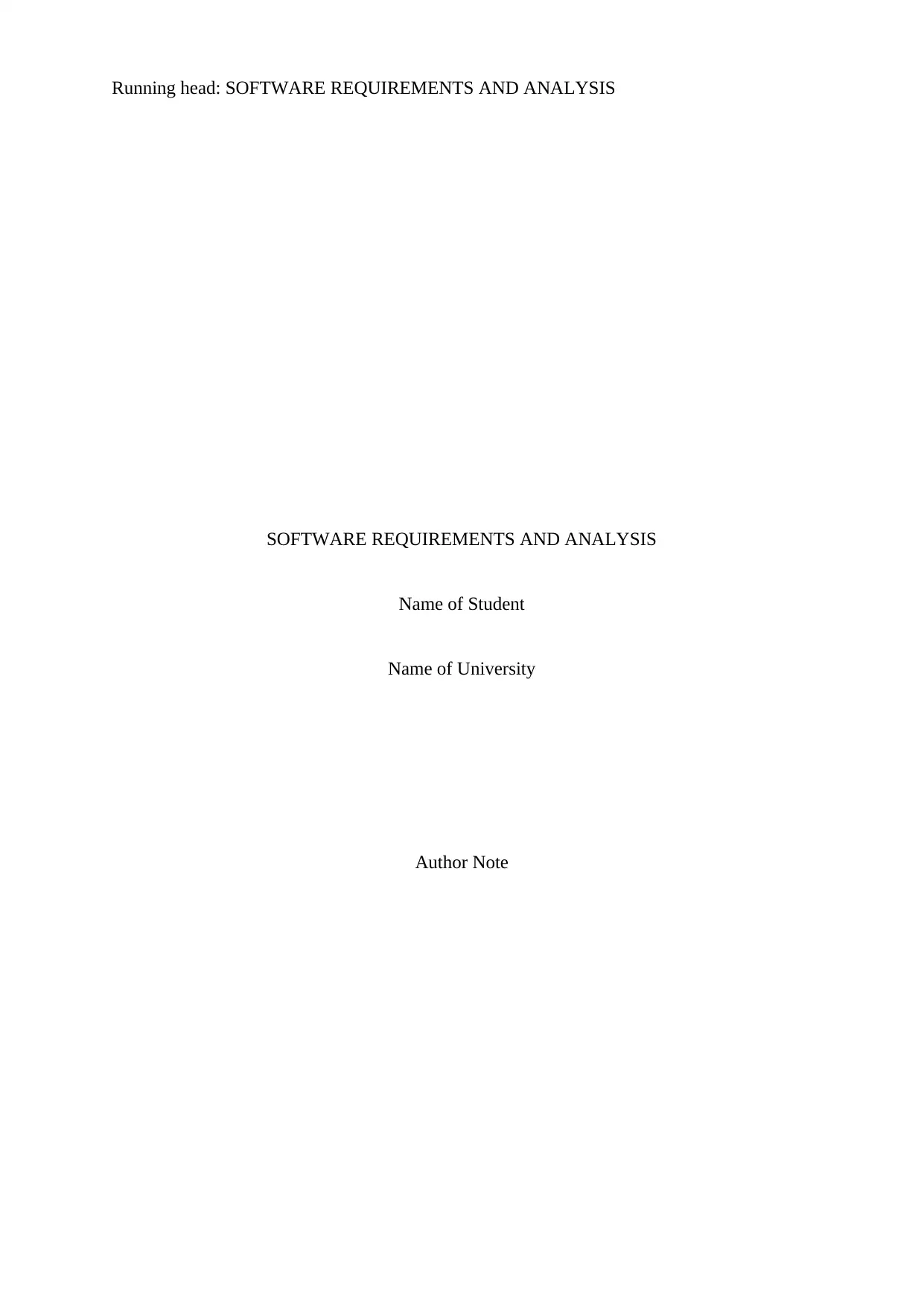
Running head: SOFTWARE REQUIREMENTS AND ANALYSIS
SOFTWARE REQUIREMENTS AND ANALYSIS
Name of Student
Name of University
Author Note
SOFTWARE REQUIREMENTS AND ANALYSIS
Name of Student
Name of University
Author Note
Paraphrase This Document
Need a fresh take? Get an instant paraphrase of this document with our AI Paraphraser
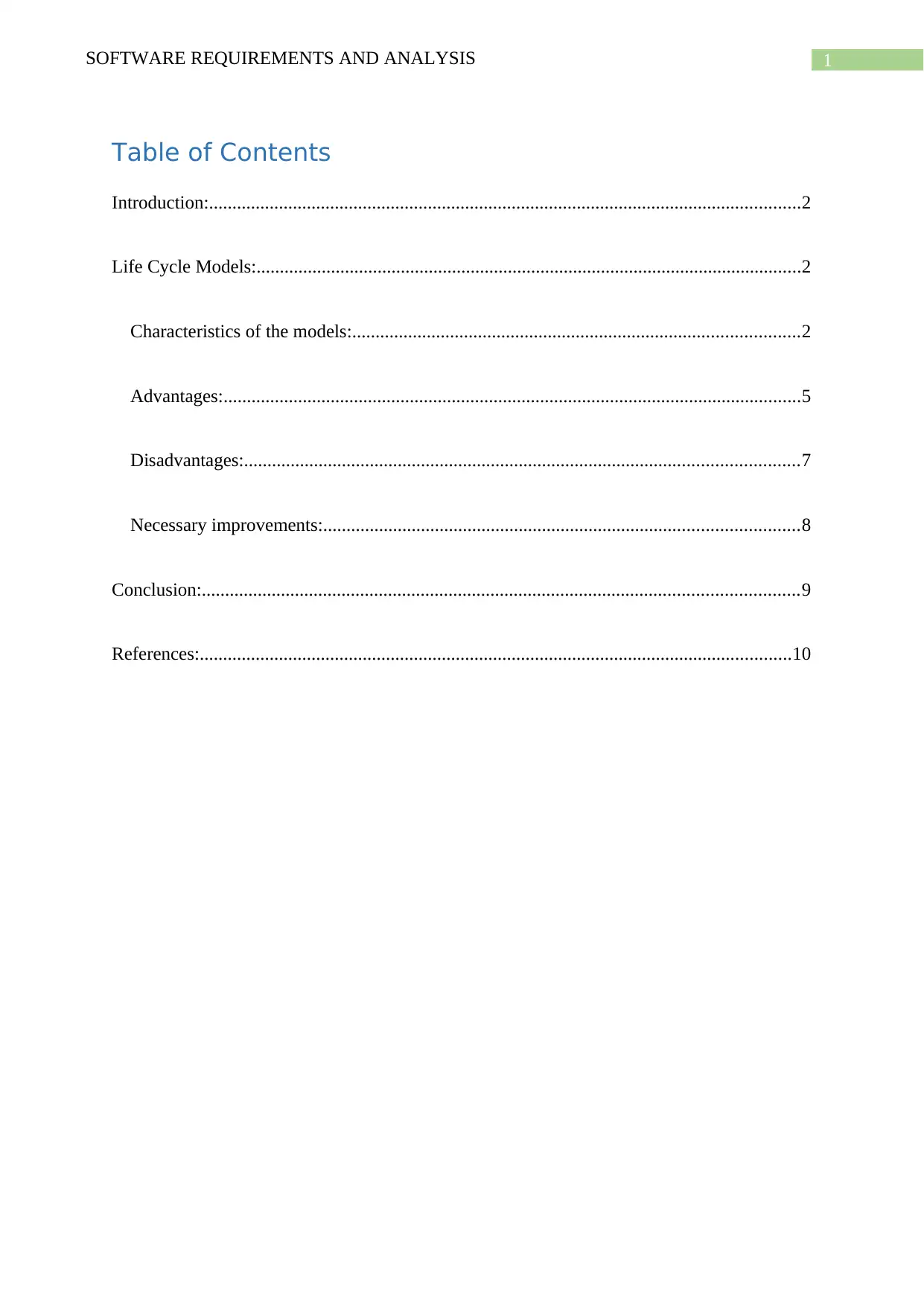
1SOFTWARE REQUIREMENTS AND ANALYSIS
Table of Contents
Introduction:...............................................................................................................................2
Life Cycle Models:.....................................................................................................................2
Characteristics of the models:................................................................................................2
Advantages:............................................................................................................................5
Disadvantages:.......................................................................................................................7
Necessary improvements:......................................................................................................8
Conclusion:................................................................................................................................9
References:...............................................................................................................................10
Table of Contents
Introduction:...............................................................................................................................2
Life Cycle Models:.....................................................................................................................2
Characteristics of the models:................................................................................................2
Advantages:............................................................................................................................5
Disadvantages:.......................................................................................................................7
Necessary improvements:......................................................................................................8
Conclusion:................................................................................................................................9
References:...............................................................................................................................10
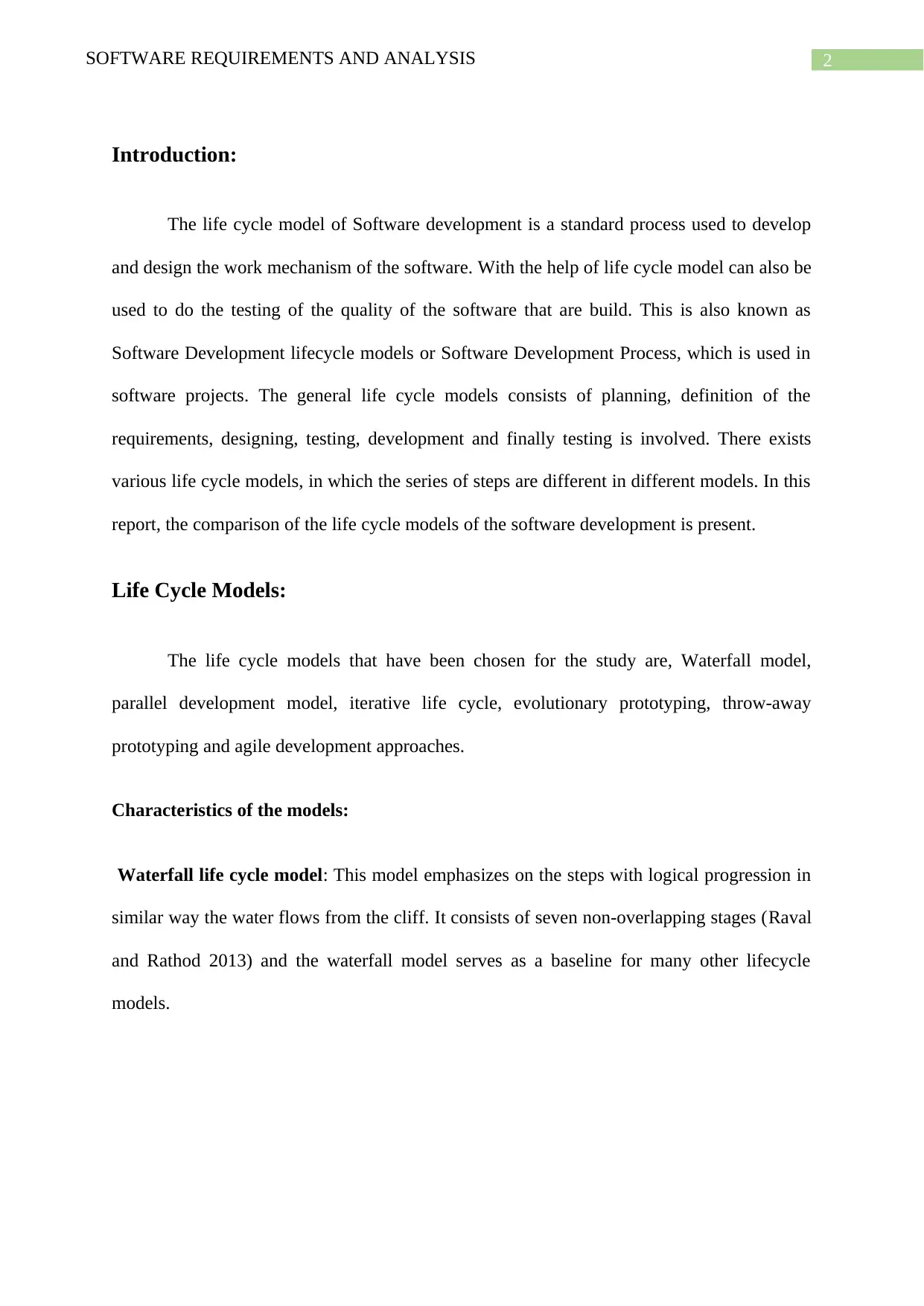
2SOFTWARE REQUIREMENTS AND ANALYSIS
Introduction:
The life cycle model of Software development is a standard process used to develop
and design the work mechanism of the software. With the help of life cycle model can also be
used to do the testing of the quality of the software that are build. This is also known as
Software Development lifecycle models or Software Development Process, which is used in
software projects. The general life cycle models consists of planning, definition of the
requirements, designing, testing, development and finally testing is involved. There exists
various life cycle models, in which the series of steps are different in different models. In this
report, the comparison of the life cycle models of the software development is present.
Life Cycle Models:
The life cycle models that have been chosen for the study are, Waterfall model,
parallel development model, iterative life cycle, evolutionary prototyping, throw-away
prototyping and agile development approaches.
Characteristics of the models:
Waterfall life cycle model: This model emphasizes on the steps with logical progression in
similar way the water flows from the cliff. It consists of seven non-overlapping stages (Raval
and Rathod 2013) and the waterfall model serves as a baseline for many other lifecycle
models.
Introduction:
The life cycle model of Software development is a standard process used to develop
and design the work mechanism of the software. With the help of life cycle model can also be
used to do the testing of the quality of the software that are build. This is also known as
Software Development lifecycle models or Software Development Process, which is used in
software projects. The general life cycle models consists of planning, definition of the
requirements, designing, testing, development and finally testing is involved. There exists
various life cycle models, in which the series of steps are different in different models. In this
report, the comparison of the life cycle models of the software development is present.
Life Cycle Models:
The life cycle models that have been chosen for the study are, Waterfall model,
parallel development model, iterative life cycle, evolutionary prototyping, throw-away
prototyping and agile development approaches.
Characteristics of the models:
Waterfall life cycle model: This model emphasizes on the steps with logical progression in
similar way the water flows from the cliff. It consists of seven non-overlapping stages (Raval
and Rathod 2013) and the waterfall model serves as a baseline for many other lifecycle
models.
⊘ This is a preview!⊘
Do you want full access?
Subscribe today to unlock all pages.

Trusted by 1+ million students worldwide
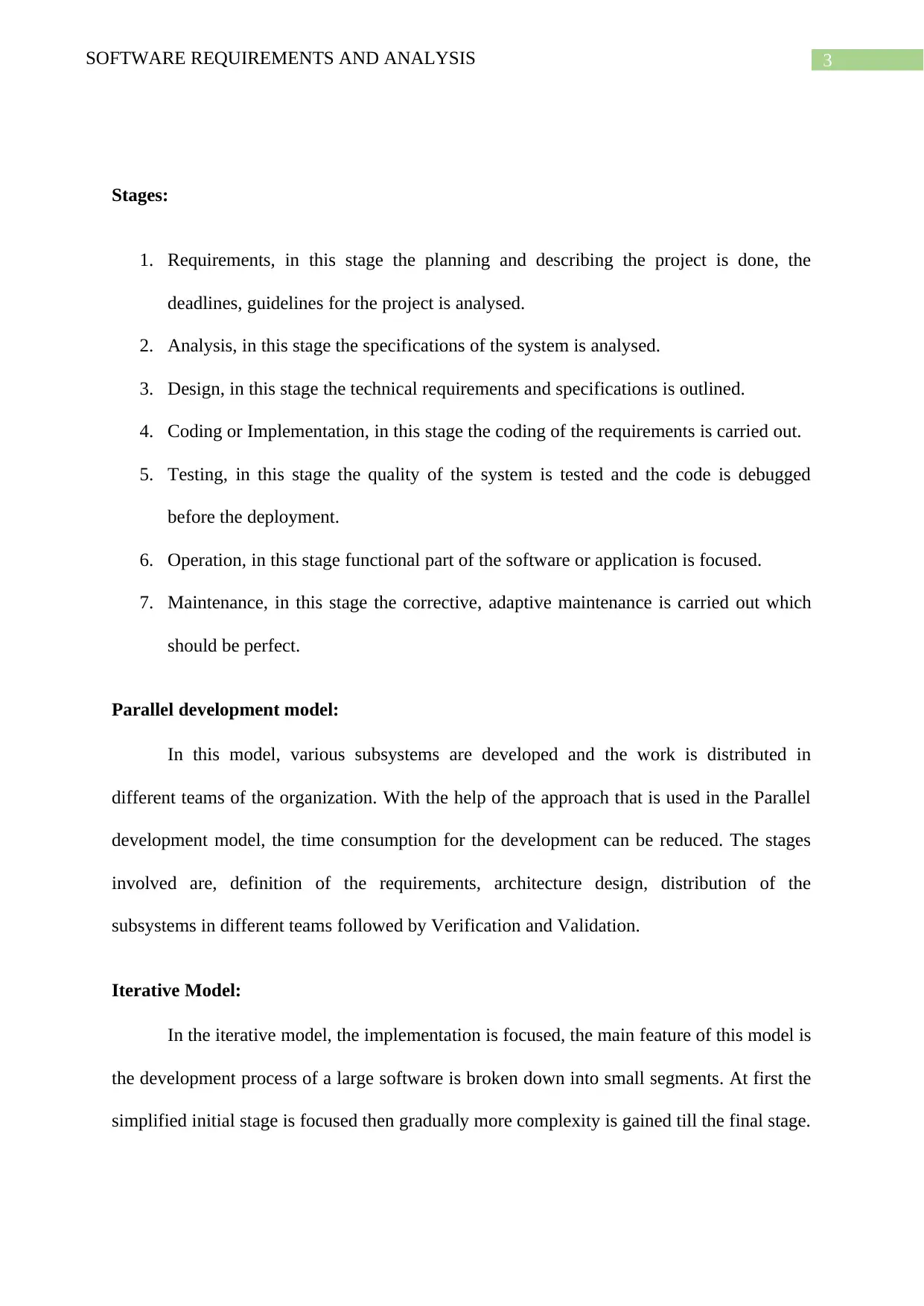
3SOFTWARE REQUIREMENTS AND ANALYSIS
Stages:
1. Requirements, in this stage the planning and describing the project is done, the
deadlines, guidelines for the project is analysed.
2. Analysis, in this stage the specifications of the system is analysed.
3. Design, in this stage the technical requirements and specifications is outlined.
4. Coding or Implementation, in this stage the coding of the requirements is carried out.
5. Testing, in this stage the quality of the system is tested and the code is debugged
before the deployment.
6. Operation, in this stage functional part of the software or application is focused.
7. Maintenance, in this stage the corrective, adaptive maintenance is carried out which
should be perfect.
Parallel development model:
In this model, various subsystems are developed and the work is distributed in
different teams of the organization. With the help of the approach that is used in the Parallel
development model, the time consumption for the development can be reduced. The stages
involved are, definition of the requirements, architecture design, distribution of the
subsystems in different teams followed by Verification and Validation.
Iterative Model:
In the iterative model, the implementation is focused, the main feature of this model is
the development process of a large software is broken down into small segments. At first the
simplified initial stage is focused then gradually more complexity is gained till the final stage.
Stages:
1. Requirements, in this stage the planning and describing the project is done, the
deadlines, guidelines for the project is analysed.
2. Analysis, in this stage the specifications of the system is analysed.
3. Design, in this stage the technical requirements and specifications is outlined.
4. Coding or Implementation, in this stage the coding of the requirements is carried out.
5. Testing, in this stage the quality of the system is tested and the code is debugged
before the deployment.
6. Operation, in this stage functional part of the software or application is focused.
7. Maintenance, in this stage the corrective, adaptive maintenance is carried out which
should be perfect.
Parallel development model:
In this model, various subsystems are developed and the work is distributed in
different teams of the organization. With the help of the approach that is used in the Parallel
development model, the time consumption for the development can be reduced. The stages
involved are, definition of the requirements, architecture design, distribution of the
subsystems in different teams followed by Verification and Validation.
Iterative Model:
In the iterative model, the implementation is focused, the main feature of this model is
the development process of a large software is broken down into small segments. At first the
simplified initial stage is focused then gradually more complexity is gained till the final stage.
Paraphrase This Document
Need a fresh take? Get an instant paraphrase of this document with our AI Paraphraser

4SOFTWARE REQUIREMENTS AND ANALYSIS
Evolutionary Prototyping:
The evolutionary approach is based on the prototypes. In many cases such as, during
research and development, only the prototypes are developed and the requirements stages
cannot developed. The spiral model is considered to be the evolutionary model in which each
cycle defines the risk evaluation at every stages and the cycle of the model does not end until
the risks are resolved. The prototypes that are included in this model are:
Illustrative user interface
Functional prototype
Exploratory prototype
Agile development approaches:
In this model the cross-functional teams of the development is generated then even if
there is less requirements then also the team proceeds towards the plan and iterations
(Abrahamsson, Salo, Ronkainen and Warsta 2017). The agile process focuses on the
requirements at every iteration.
Throw-away prototyping:
The objective of this prototype is to provide assurance that the requirements of the
software are validated and clarified. In this prototype, a smaller segment of the software or
system is processed for the development and served to the client to use and examine. Then
the user or client provides feedback after using that segment and according to that feedback
necessary modifications is included in the development process of the main software. Later,
the used prototype is thrown away.
Evolutionary Prototyping:
The evolutionary approach is based on the prototypes. In many cases such as, during
research and development, only the prototypes are developed and the requirements stages
cannot developed. The spiral model is considered to be the evolutionary model in which each
cycle defines the risk evaluation at every stages and the cycle of the model does not end until
the risks are resolved. The prototypes that are included in this model are:
Illustrative user interface
Functional prototype
Exploratory prototype
Agile development approaches:
In this model the cross-functional teams of the development is generated then even if
there is less requirements then also the team proceeds towards the plan and iterations
(Abrahamsson, Salo, Ronkainen and Warsta 2017). The agile process focuses on the
requirements at every iteration.
Throw-away prototyping:
The objective of this prototype is to provide assurance that the requirements of the
software are validated and clarified. In this prototype, a smaller segment of the software or
system is processed for the development and served to the client to use and examine. Then
the user or client provides feedback after using that segment and according to that feedback
necessary modifications is included in the development process of the main software. Later,
the used prototype is thrown away.
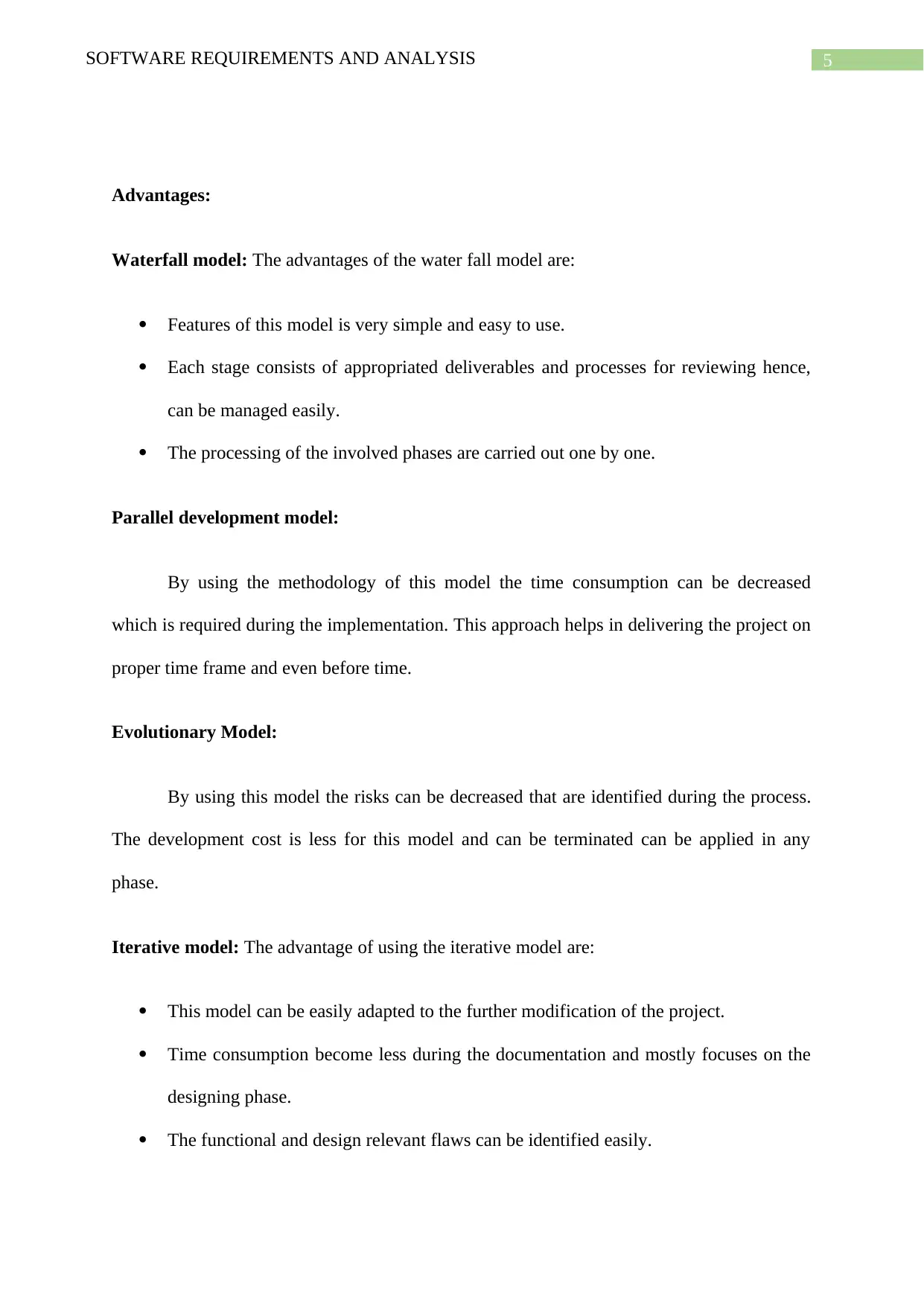
5SOFTWARE REQUIREMENTS AND ANALYSIS
Advantages:
Waterfall model: The advantages of the water fall model are:
Features of this model is very simple and easy to use.
Each stage consists of appropriated deliverables and processes for reviewing hence,
can be managed easily.
The processing of the involved phases are carried out one by one.
Parallel development model:
By using the methodology of this model the time consumption can be decreased
which is required during the implementation. This approach helps in delivering the project on
proper time frame and even before time.
Evolutionary Model:
By using this model the risks can be decreased that are identified during the process.
The development cost is less for this model and can be terminated can be applied in any
phase.
Iterative model: The advantage of using the iterative model are:
This model can be easily adapted to the further modification of the project.
Time consumption become less during the documentation and mostly focuses on the
designing phase.
The functional and design relevant flaws can be identified easily.
Advantages:
Waterfall model: The advantages of the water fall model are:
Features of this model is very simple and easy to use.
Each stage consists of appropriated deliverables and processes for reviewing hence,
can be managed easily.
The processing of the involved phases are carried out one by one.
Parallel development model:
By using the methodology of this model the time consumption can be decreased
which is required during the implementation. This approach helps in delivering the project on
proper time frame and even before time.
Evolutionary Model:
By using this model the risks can be decreased that are identified during the process.
The development cost is less for this model and can be terminated can be applied in any
phase.
Iterative model: The advantage of using the iterative model are:
This model can be easily adapted to the further modification of the project.
Time consumption become less during the documentation and mostly focuses on the
designing phase.
The functional and design relevant flaws can be identified easily.
⊘ This is a preview!⊘
Do you want full access?
Subscribe today to unlock all pages.

Trusted by 1+ million students worldwide
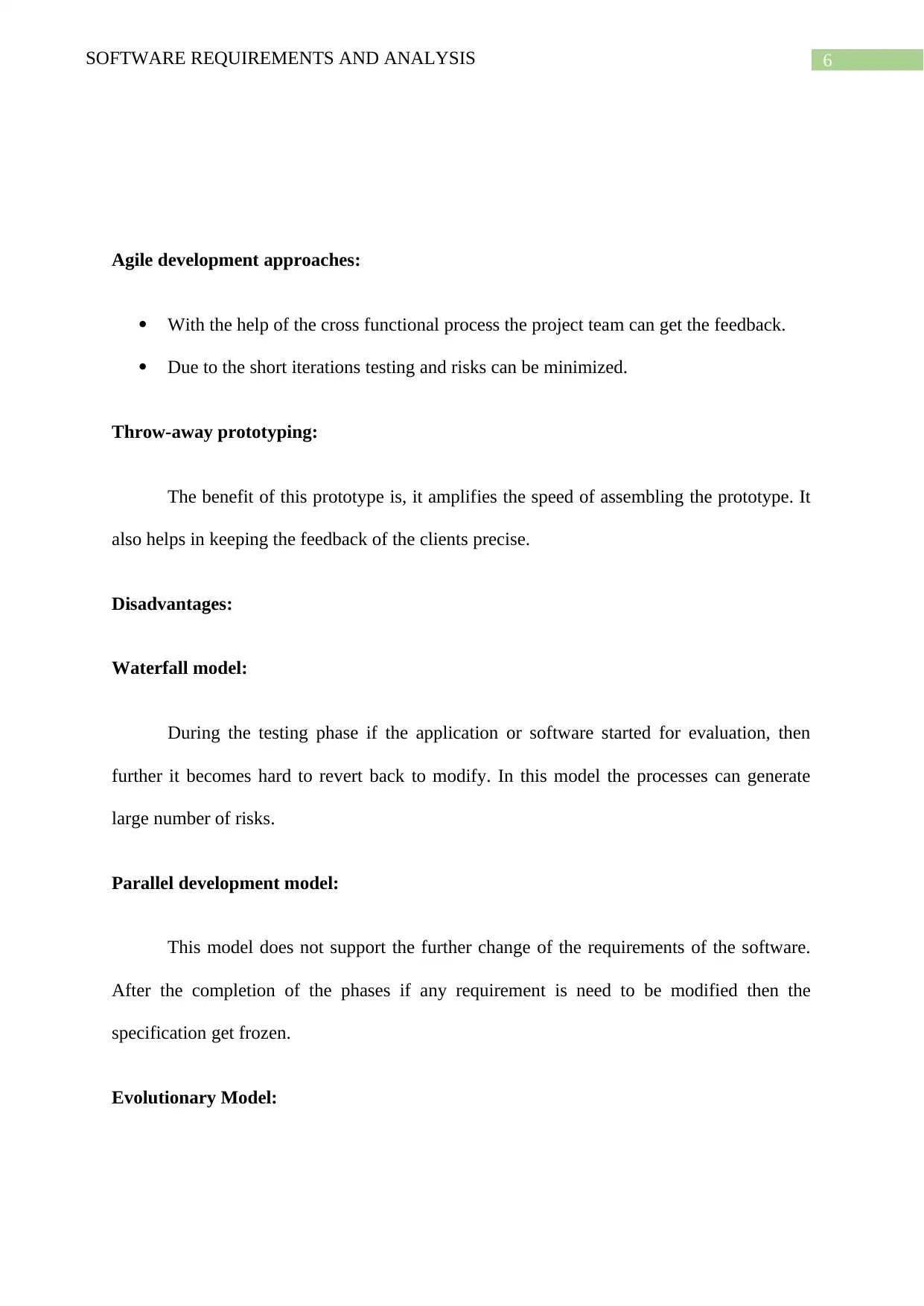
6SOFTWARE REQUIREMENTS AND ANALYSIS
Agile development approaches:
With the help of the cross functional process the project team can get the feedback.
Due to the short iterations testing and risks can be minimized.
Throw-away prototyping:
The benefit of this prototype is, it amplifies the speed of assembling the prototype. It
also helps in keeping the feedback of the clients precise.
Disadvantages:
Waterfall model:
During the testing phase if the application or software started for evaluation, then
further it becomes hard to revert back to modify. In this model the processes can generate
large number of risks.
Parallel development model:
This model does not support the further change of the requirements of the software.
After the completion of the phases if any requirement is need to be modified then the
specification get frozen.
Evolutionary Model:
Agile development approaches:
With the help of the cross functional process the project team can get the feedback.
Due to the short iterations testing and risks can be minimized.
Throw-away prototyping:
The benefit of this prototype is, it amplifies the speed of assembling the prototype. It
also helps in keeping the feedback of the clients precise.
Disadvantages:
Waterfall model:
During the testing phase if the application or software started for evaluation, then
further it becomes hard to revert back to modify. In this model the processes can generate
large number of risks.
Parallel development model:
This model does not support the further change of the requirements of the software.
After the completion of the phases if any requirement is need to be modified then the
specification get frozen.
Evolutionary Model:
Paraphrase This Document
Need a fresh take? Get an instant paraphrase of this document with our AI Paraphraser
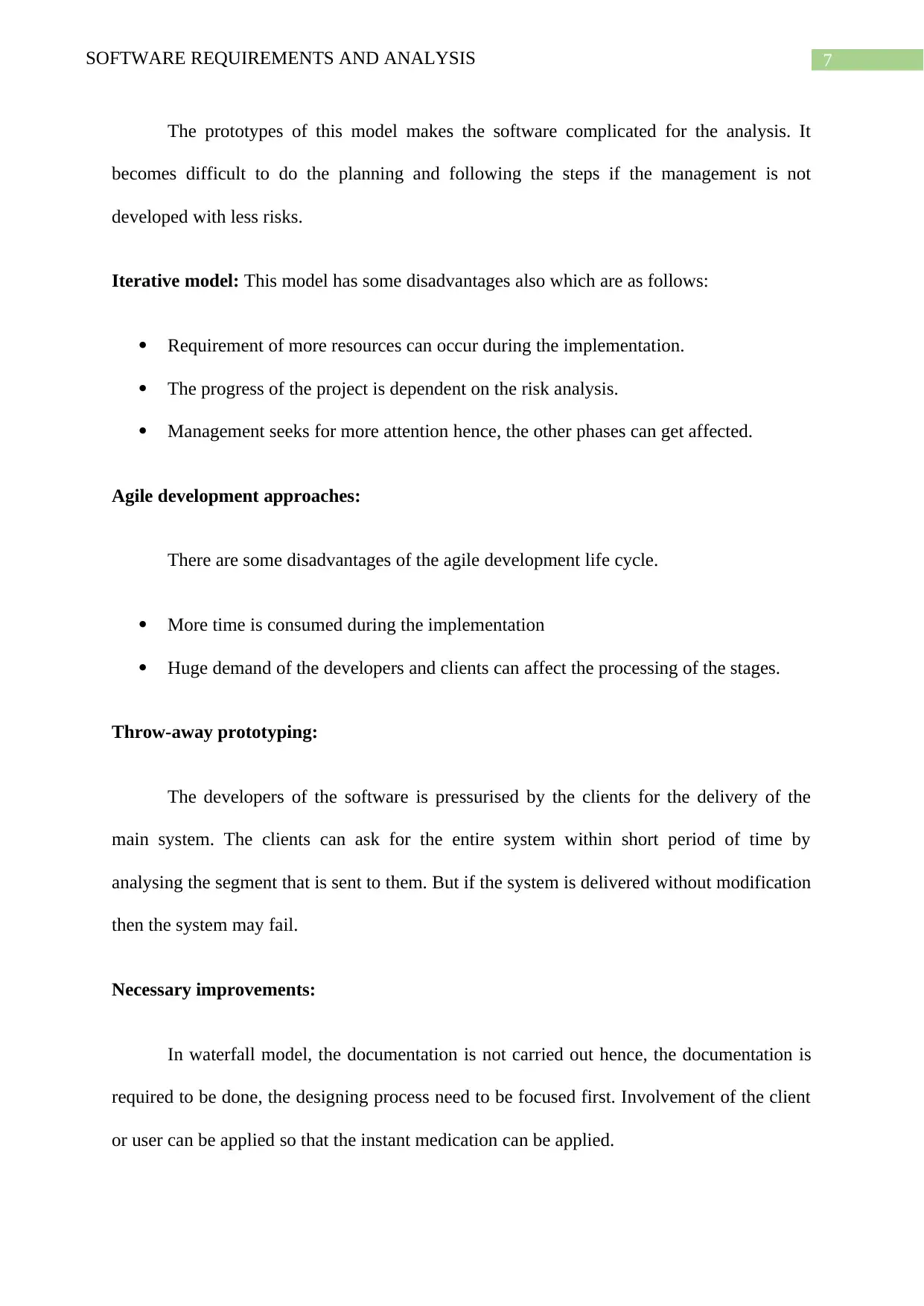
7SOFTWARE REQUIREMENTS AND ANALYSIS
The prototypes of this model makes the software complicated for the analysis. It
becomes difficult to do the planning and following the steps if the management is not
developed with less risks.
Iterative model: This model has some disadvantages also which are as follows:
Requirement of more resources can occur during the implementation.
The progress of the project is dependent on the risk analysis.
Management seeks for more attention hence, the other phases can get affected.
Agile development approaches:
There are some disadvantages of the agile development life cycle.
More time is consumed during the implementation
Huge demand of the developers and clients can affect the processing of the stages.
Throw-away prototyping:
The developers of the software is pressurised by the clients for the delivery of the
main system. The clients can ask for the entire system within short period of time by
analysing the segment that is sent to them. But if the system is delivered without modification
then the system may fail.
Necessary improvements:
In waterfall model, the documentation is not carried out hence, the documentation is
required to be done, the designing process need to be focused first. Involvement of the client
or user can be applied so that the instant medication can be applied.
The prototypes of this model makes the software complicated for the analysis. It
becomes difficult to do the planning and following the steps if the management is not
developed with less risks.
Iterative model: This model has some disadvantages also which are as follows:
Requirement of more resources can occur during the implementation.
The progress of the project is dependent on the risk analysis.
Management seeks for more attention hence, the other phases can get affected.
Agile development approaches:
There are some disadvantages of the agile development life cycle.
More time is consumed during the implementation
Huge demand of the developers and clients can affect the processing of the stages.
Throw-away prototyping:
The developers of the software is pressurised by the clients for the delivery of the
main system. The clients can ask for the entire system within short period of time by
analysing the segment that is sent to them. But if the system is delivered without modification
then the system may fail.
Necessary improvements:
In waterfall model, the documentation is not carried out hence, the documentation is
required to be done, the designing process need to be focused first. Involvement of the client
or user can be applied so that the instant medication can be applied.
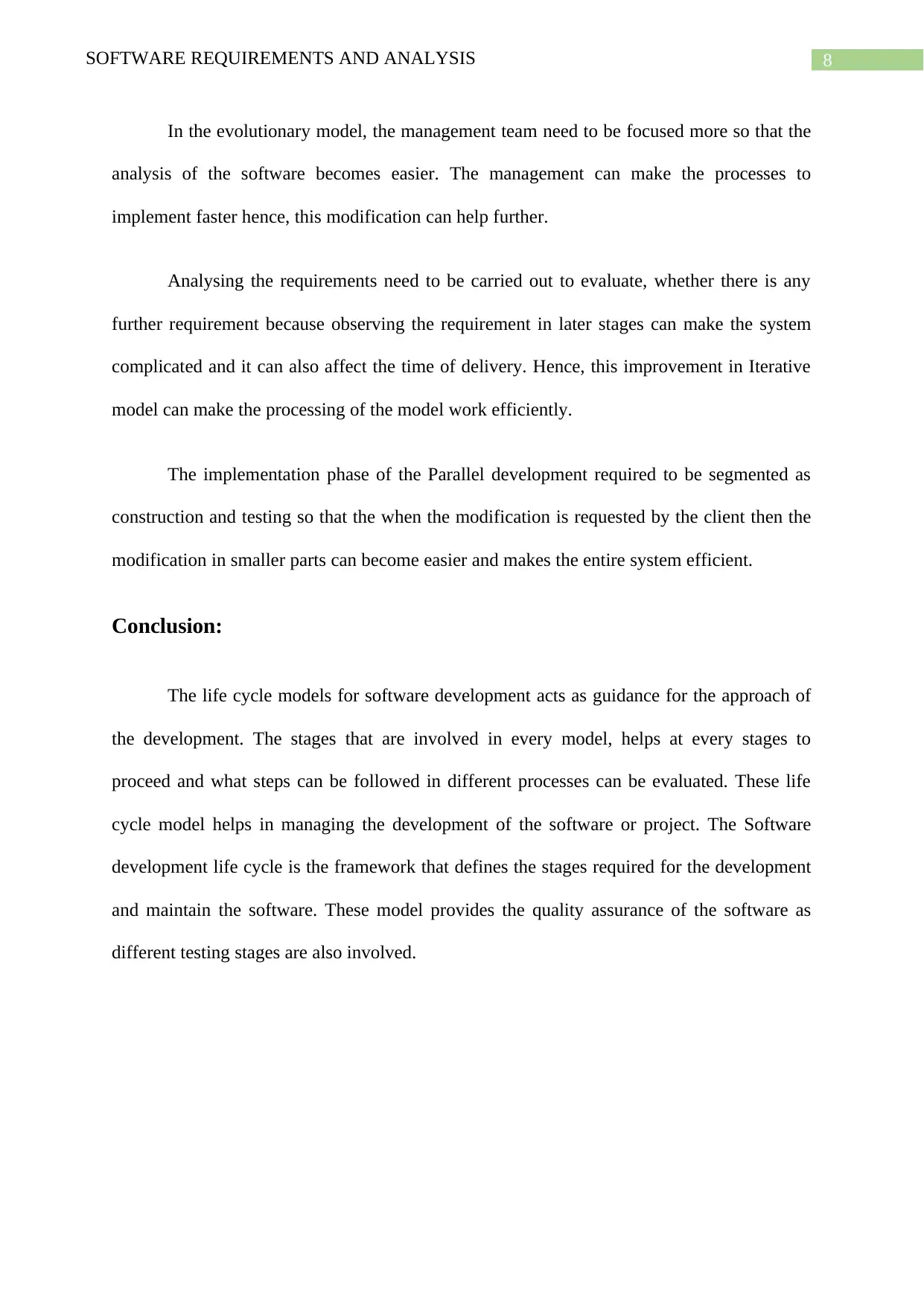
8SOFTWARE REQUIREMENTS AND ANALYSIS
In the evolutionary model, the management team need to be focused more so that the
analysis of the software becomes easier. The management can make the processes to
implement faster hence, this modification can help further.
Analysing the requirements need to be carried out to evaluate, whether there is any
further requirement because observing the requirement in later stages can make the system
complicated and it can also affect the time of delivery. Hence, this improvement in Iterative
model can make the processing of the model work efficiently.
The implementation phase of the Parallel development required to be segmented as
construction and testing so that the when the modification is requested by the client then the
modification in smaller parts can become easier and makes the entire system efficient.
Conclusion:
The life cycle models for software development acts as guidance for the approach of
the development. The stages that are involved in every model, helps at every stages to
proceed and what steps can be followed in different processes can be evaluated. These life
cycle model helps in managing the development of the software or project. The Software
development life cycle is the framework that defines the stages required for the development
and maintain the software. These model provides the quality assurance of the software as
different testing stages are also involved.
In the evolutionary model, the management team need to be focused more so that the
analysis of the software becomes easier. The management can make the processes to
implement faster hence, this modification can help further.
Analysing the requirements need to be carried out to evaluate, whether there is any
further requirement because observing the requirement in later stages can make the system
complicated and it can also affect the time of delivery. Hence, this improvement in Iterative
model can make the processing of the model work efficiently.
The implementation phase of the Parallel development required to be segmented as
construction and testing so that the when the modification is requested by the client then the
modification in smaller parts can become easier and makes the entire system efficient.
Conclusion:
The life cycle models for software development acts as guidance for the approach of
the development. The stages that are involved in every model, helps at every stages to
proceed and what steps can be followed in different processes can be evaluated. These life
cycle model helps in managing the development of the software or project. The Software
development life cycle is the framework that defines the stages required for the development
and maintain the software. These model provides the quality assurance of the software as
different testing stages are also involved.
⊘ This is a preview!⊘
Do you want full access?
Subscribe today to unlock all pages.

Trusted by 1+ million students worldwide

9SOFTWARE REQUIREMENTS AND ANALYSIS
References:
Abrahamsson, P., Salo, O., Ronkainen, J. and Warsta, J., 2017. Agile software development
methods: Review and analysis. arXiv preprint arXiv:1709.08439.
Hauschild, M.Z., Goedkoop, M., Guinée, J., Heijungs, R., Huijbregts, M., Jolliet, O., Margni,
M., De Schryver, A., Humbert, S., Laurent, A. and Sala, S., 2013. Identifying best existing
practice for characterization modeling in life cycle impact assessment. The International
Journal of Life Cycle Assessment, 18(3), pp.683-697.
Isaias, P. and Issa, T., 2015. Information system development life cycle models. In High
Level Models and Methodologies for Information Systems (pp. 21-40). Springer, New York,
NY.
Matharu, G.S., Mishra, A., Singh, H. and Upadhyay, P., 2015. Empirical study of agile
software development methodologies: A comparative analysis. ACM SIGSOFT Software
Engineering Notes, 40(1), pp.1-6.
Parisi, M.L., Maranghi, S. and Basosi, R., 2014. The evolution of the dye sensitized solar
cells from Grätzel prototype to up-scaled solar applications: A life cycle assessment
approach. Renewable and Sustainable Energy Reviews, 39, pp.124-138.
Raval, R.R. and Rathod, H.M., 2013. Comparative study of various process model in
software development. International Journal of Computer Applications, 82(18).
Stoica, M., Mircea, M. and Ghilic-Micu, B., 2013. Software Development: Agile vs.
Traditional. Informatica Economica, 17(4).
References:
Abrahamsson, P., Salo, O., Ronkainen, J. and Warsta, J., 2017. Agile software development
methods: Review and analysis. arXiv preprint arXiv:1709.08439.
Hauschild, M.Z., Goedkoop, M., Guinée, J., Heijungs, R., Huijbregts, M., Jolliet, O., Margni,
M., De Schryver, A., Humbert, S., Laurent, A. and Sala, S., 2013. Identifying best existing
practice for characterization modeling in life cycle impact assessment. The International
Journal of Life Cycle Assessment, 18(3), pp.683-697.
Isaias, P. and Issa, T., 2015. Information system development life cycle models. In High
Level Models and Methodologies for Information Systems (pp. 21-40). Springer, New York,
NY.
Matharu, G.S., Mishra, A., Singh, H. and Upadhyay, P., 2015. Empirical study of agile
software development methodologies: A comparative analysis. ACM SIGSOFT Software
Engineering Notes, 40(1), pp.1-6.
Parisi, M.L., Maranghi, S. and Basosi, R., 2014. The evolution of the dye sensitized solar
cells from Grätzel prototype to up-scaled solar applications: A life cycle assessment
approach. Renewable and Sustainable Energy Reviews, 39, pp.124-138.
Raval, R.R. and Rathod, H.M., 2013. Comparative study of various process model in
software development. International Journal of Computer Applications, 82(18).
Stoica, M., Mircea, M. and Ghilic-Micu, B., 2013. Software Development: Agile vs.
Traditional. Informatica Economica, 17(4).
Paraphrase This Document
Need a fresh take? Get an instant paraphrase of this document with our AI Paraphraser
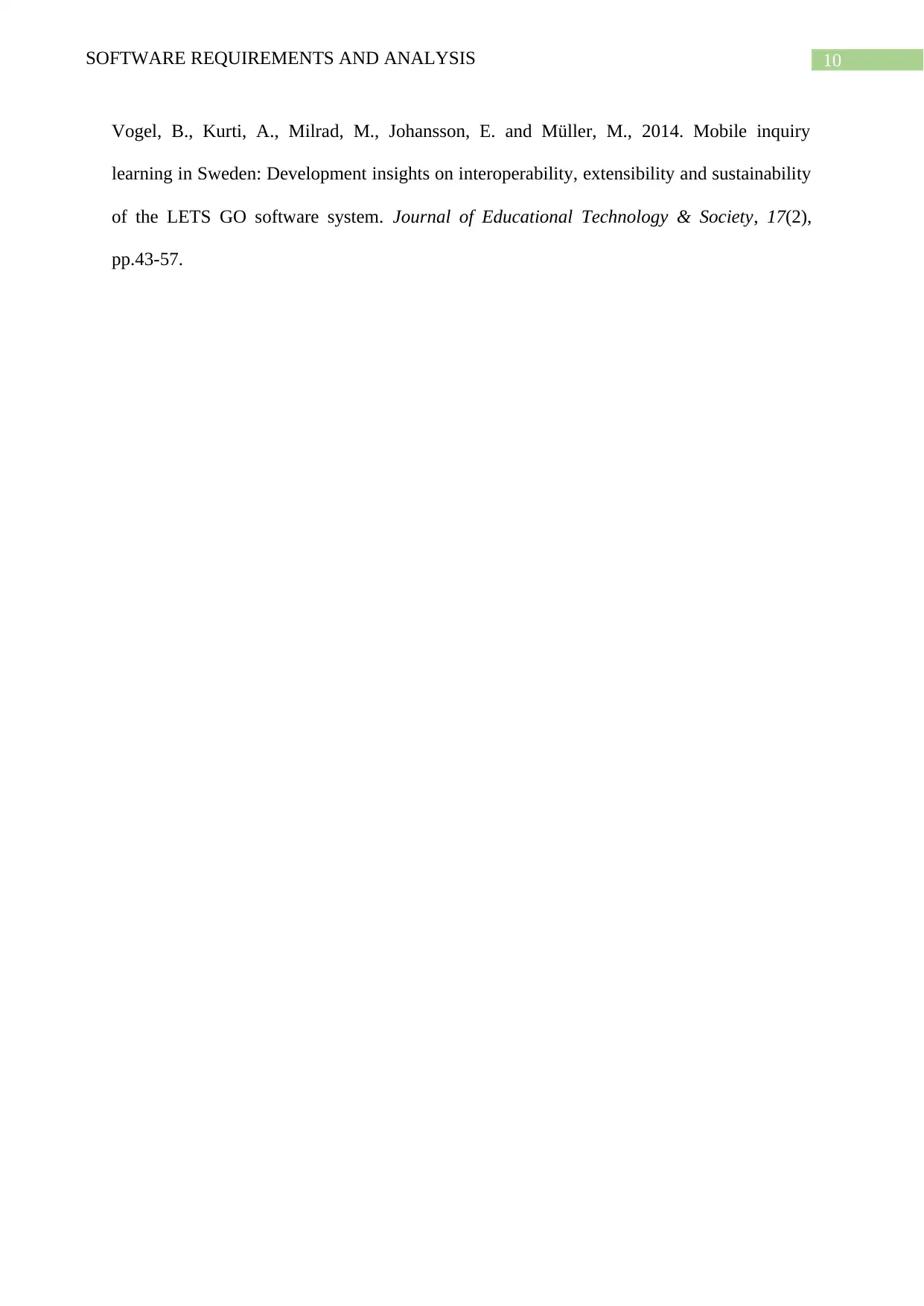
10SOFTWARE REQUIREMENTS AND ANALYSIS
Vogel, B., Kurti, A., Milrad, M., Johansson, E. and Müller, M., 2014. Mobile inquiry
learning in Sweden: Development insights on interoperability, extensibility and sustainability
of the LETS GO software system. Journal of Educational Technology & Society, 17(2),
pp.43-57.
Vogel, B., Kurti, A., Milrad, M., Johansson, E. and Müller, M., 2014. Mobile inquiry
learning in Sweden: Development insights on interoperability, extensibility and sustainability
of the LETS GO software system. Journal of Educational Technology & Society, 17(2),
pp.43-57.
1 out of 11
Related Documents
Your All-in-One AI-Powered Toolkit for Academic Success.
+13062052269
info@desklib.com
Available 24*7 on WhatsApp / Email
![[object Object]](/_next/static/media/star-bottom.7253800d.svg)
Unlock your academic potential
Copyright © 2020–2025 A2Z Services. All Rights Reserved. Developed and managed by ZUCOL.





